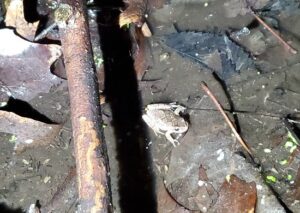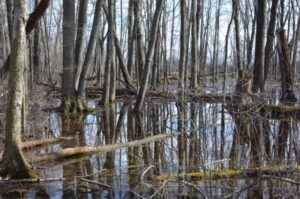By Annika Moran, Huron Pines AmeriCorps Member
Each year, the AmeriCorps members serving with Legacy Land Conservancy are tasked with carrying out a project of their choice at Legacy’s preserves. These projects can range from studying plants to inventorying wildlife to surveying preserve visitors about their experiences. As someone with an interest in just about everything nature-related, choosing a theme for my project was an exciting—if even a bit overwhelming—task. Ultimately, inspired by my experience preparing for the Michigan Vernal Pool Patrol, I decided to survey the Lloyd and Mabel Johnson Preserve for breeding frog populations.
Frogs are not only charismatic and adorable; they also act as important indicators for several environmental characteristics due to their unique habitat and physiological needs. For example, the wood frog (Lithobates sylvaticus) is known as a vernal pool indicator species, whose presence points to the existence of a vernal pool—unique and understudied habitats in Michigan that support a diverse array of terrestrial and aquatic life. When I visited the forest in the Johnson preserve on a warm, drizzling night in late March, I heard male wood frogs calling for mates with their characteristic short, rough croaks, sounding almost like tiny, excitable ducks.
Heading out of the forest and into the prairie brought me into a whole new community of frog species. In smaller, shallower wet depressions among the prairie grasses and forbs, chorus frogs (Pseudacris triseriata) let out long, trilling calls—like a finger running along the tines of a comb. American toads (Anaxyrus americanus) joined in with their eerily beautiful, harmonizing song. And spring peepers (P. crucifer) punctuated it all with their short, high-pitched cries.
As I continued visiting the Johnson Preserve later in the spring, the mosaic of species comprising the preserve’s soundtrack shifted. The weather dried and the vernal pool contracted, so wood frogs completed their breeding and laid their eggs so that their tadpoles could begin the race to develop into adults before the pool dried up completely in the summer. Filling their space in the soundscape were the green frogs (Lithobates clamitans) with their banjo-string-like voices and the gray treefrogs (Hyla versicolor), whose short, trilling calls came not from the pools below but the branches above.
As our environment changes due to the climate crisis, land development and ongoing ecological restoration, wildlife surveys like my project can help future stewards of the land understand where we were at this moment in time. My survey found breeding populations of six species of native frogs, but I also noted the lack of four frog species that might have inhabited this preserve in the past: the American bullfrog (L. catesbeianus), northern cricket frog (Acris crepitans), leopard frog (L. pipiens) and pickerel frog (L. palustris).

A spring peeper seen at night. This common species can be found in shallow wet depressions, ponds and vernal pools.
Moving forward, some of these species may reappear at the preserve, or some of the species I heard this year may disappear from their habitats. Whatever the case may be, surveys like mine offer a snapshot into animal and plant communities in the preserve, and offer a baseline upon which future surveys can build a greater understanding of changing natural landscapes and ecosystems.



 RSS Feed
RSS Feed